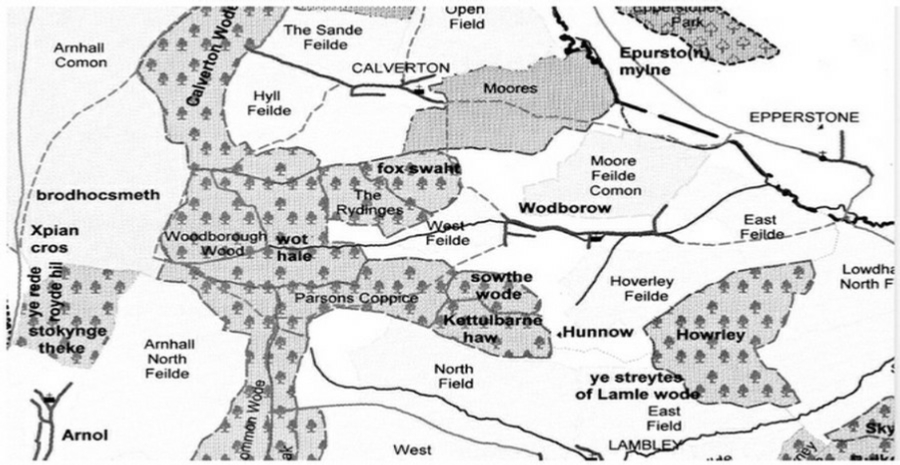Woodborough’s Heritage
An ancient Sherwood Forest village, recorded in Domesday
Ancient woodlands surrounding Woodborough
Ploughman Wood Nature Reserve:
Ploughman Wood (shown on the medieval Sherwood Forest map circa 1400 below as just Howrley; but later recorded as Hoeverly Woode on the 1609 Sherwood Forest Map) is within the neighbouring Parish of Lowdham, and strictly speaking would therefore not normally be part of our research. Our brief is to write and inform only about Woodborough Parish matters, however, this wood so dominates our southern skyline that it seems right for us to include it. (Ed 2002). We thank the Nottinghamshire Wildlife Trust for supplying the following text. For additional information on the Trust try their web site www.nottinghamshirewildlife.org.
View of Woodborough from Ploughman Wood.
Ploughman Wood was donated to the Nottinghamshire Wildlife Trust by the Home Office in 1996. Covering over 32 hectares, this is one of Nottinghamshire’s few remaining ancient woodlands. Documentary evidence shows that it dates back to the 13th century and was part of an area of woodland covering more than 120 hectares. It would have formed part of the south-eastern extremity of the greater Sherwood Forest.
This 1400 Medieval map of Sherwood Forest shows the proximity of Howrley to Woodborough.
The trees, which are mainly oak and ash with some hazel, holly, field maple and beech, provide an excellent range of habitats for wildlife. Some non-native trees such as Corsican pine, European larch and sycamore will be removed to restore a more natural balance of species.
In spring, the wood is carpeted with bluebells. Other plants which are typical and found in this ancient woodland include red campion, yellow archangel, wood anemone and wood melick [a type of grass]. Honeysuckle can also be seen throughout the wood climbing through trees and shrubs. All four photographs below were taken in Spring 2003.
.jpg)
.jpg)
.jpg)
.jpg)
The wood contains substantial quantities of dead wood providing an excellent habitat for a wide range of flora, and fauna, including bracket fungi, beetles, bats and hole nesting birds. Over 280 species of invertebrates have been recorded so far.
On the south side of the wood, a pond has been excavated and a new meadow area was created in 1998. In time these areas should attract dragonflies, damselflies and other insects. A kiln was installed recently to produce charcoal and this will be sold through local outlets.
.jpg)
.jpg)
Charcoal kiln and cut wood in 2002.
Below a view of Ploughman Wood taken from Private Road looking over and beyond St Swithun's Church.
Acknowledgements:
- Nottinghamshire Wildlife Trust.
- Nottinghamshire County Council (1400 Sherwood Forest Map).
- Photographs by John Hoyland.
____________________________________________________________________________________________________
 Next page
Back to top
Next page
Back to top
| Navigate this site |
| 001 Timeline |
| 100 - 114 St Swithuns Church - Index |
| 115 - 121 Churchyard & Cemetery - Index |
| 122 - 128 Methodist Church - Index |
| 129 - 131 Baptist Chapel - Index |
| 132 - 132.4 Institute - Index |
| 129 - A History of the Chapel |
| 130 - Baptist Chapel School (Lilly's School) |
| 131 - Baptist Chapel internment |
| 132 - The Institute from 1826 |
| 132.1 Institute Minutes |
| 132.2 Iinstitute Deeds 1895 |
| 132.3 Institute Deeds 1950 |
| 132.4 Institute letters and bills |
| 134 - 138 Woodborough Hall - Index |
| 139 - 142 The Manor House Index |
| 143 - Nether Hall |
| 139 - Middle Manor from 1066 |
| 140 - The Wood Family |
| 141 - Manor Farm & Stables |
| 142 - Robert Howett & Mundens Hall |
| 200 - Buckland by Peter Saunders |
| 201 - Buckland - Introduction & Obituary |
| 202 - Buckland Title & Preface |
| 203 - Buckland Chapter List & Summaries of Content |
| 224 - 19th Century Woodborough |
| 225 - Community Study 1967 |
| 226 - Community Study 1974 |
| 227 - Community Study 1990 |
| 400 - 402 Drains & Dykes - Index |
| 403 - 412 Flooding - Index |
| 413 - 420 Woodlands - Index |
| 421 - 437 Enclosure 1795 - Index |
| 440 - 451 Land Misc - Index |
| 400 - Introduction |
| 401 - Woodborough Dykes at Enclosure 1795 |
| 402 - A Study of Land Drainage & Farming Practices |
| People A to H 600+ |
| People L to W 629 |
| 640 - Sundry deaths |
| 650 - Bish Family |
| 651 - Ward Family |
| 652 - Alveys of Woodborough |
| 653 - Alvey marriages |
| 654 - Alvey Burials |
| 800 - Footpaths Introduction |
| 801 - Lapwing Trail |
| 802 - WI Trail |